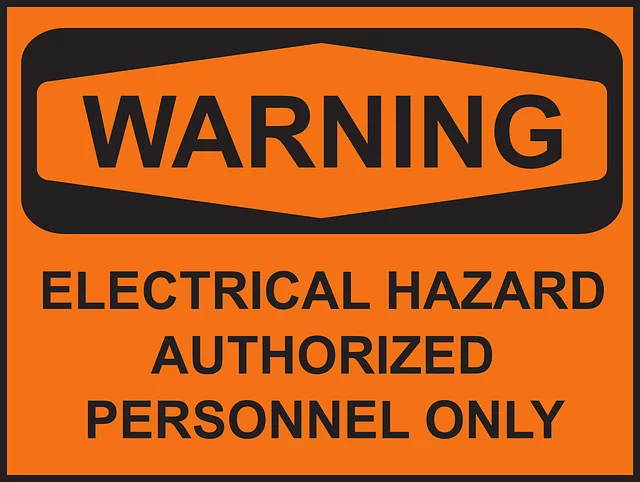Arc Flash Hazard Analysis is a comprehensive approach to electrical safety compliance, focusing on arc flash risk reduction. This process identifies and assesses potential hazards by examining energy release, arc duration, and protective equipment effectiveness. Key strategies include implementing structured labeling systems with warning symbols, risk descriptions, and safe work practices, adhering to industry standards (e.g., NEC), regularly reviewing and updating labels, and training personnel on label interpretation to maintain a safer work environment.
Electrical panels are vital components of any facility’s infrastructure, but they also pose significant risks. This article explores the critical aspects of safety labeling for electrical panels, focusing on arc flash hazard analysis and arc flash risk reduction. We delve into the role of electrical safety compliance in minimizing dangers and provide a comprehensive guide to implementing effective labeling strategies. Additionally, best practices for maintaining and updating safety labels are discussed to ensure continuous protection.
- Understanding Arc Flash Hazard Analysis: A Comprehensive Guide
- The Role of Electrical Safety Compliance in Risk Reduction
- Implementing Effective Labeling Strategies for Arc Flash Risk Mitigation
- Best Practices for Maintaining and Updating Safety Labels on Electrical Panels
Understanding Arc Flash Hazard Analysis: A Comprehensive Guide
Understanding Arc Flash Hazard Analysis is a critical step in ensuring electrical safety compliance. This comprehensive guide delves into identifying and evaluating the potential risks associated with arc flash events, which can cause severe injuries or even fatalities. By meticulously assessing factors like energy release, arc duration, and protective equipment effectiveness, organizations can implement effective strategies for arc flash risk reduction.
A meticulous Arc Flash Hazard Analysis involves a systematic approach to navigate through complex electrical systems. It requires a thorough understanding of the equipment, circuit configurations, and human factors at play. This analysis not only informs the selection of appropriate safety labels but also guides the development of comprehensive safety protocols, ensuring that all personnel are equipped with the knowledge and resources necessary to maintain a safe working environment around electrical panels.
The Role of Electrical Safety Compliance in Risk Reduction
Electrical safety compliance plays a pivotal role in risk reduction within industrial and commercial settings. By adhering to stringent electrical safety standards, organizations can significantly mitigate potential hazards that often go unnoticed until it’s too late. One such critical area of focus is arc flash hazard analysis, which involves identifying and evaluating the risks associated with sudden, intense releases of energy caused by electrical arcs.
Through thorough assessments, companies can implement effective strategies for arc flash risk reduction, such as proper labeling, engineering controls, and personal protective equipment (PPE). These measures ensure that workers are adequately informed and protected, thereby minimizing the likelihood of severe injuries or fatalities during unexpected electrical events. Electrical safety compliance is not just a regulatory requirement but a fundamental practice that contributes to fostering a safer working environment.
Implementing Effective Labeling Strategies for Arc Flash Risk Mitigation
Implementing effective labeling strategies is a critical step in mitigating arc flash hazards and ensuring electrical safety compliance. An arc flash is a powerful, explosive release of energy that can occur when electrical equipment is exposed to fault conditions. Proper labeling helps identify potential risks, providing essential information for workers navigating these environments.
A comprehensive arc flash hazard analysis should be conducted to determine the likelihood and severity of such events. This analysis guides the development of tailored labeling solutions. For instance, labels can include specific warning symbols, clear descriptions of the associated risks, and instructions for safe work practices. By adhering to industry standards and best practices, organizations can reduce arc flash risk, protect personnel, and maintain regulatory compliance.
Best Practices for Maintaining and Updating Safety Labels on Electrical Panels
Maintaining accurate and up-to-date safety labels on electrical panels is paramount for ensuring worker safety and adhering to electrical safety regulations, especially when dealing with potential arc flash hazards. Regular reviews and updates are necessary to reflect changes in equipment, operating procedures, or risk assessments. A best practice is to establish a comprehensive labeling system that includes clear pictograms and concise text, specifically tailored to the unique risks associated with each panel. This involves conducting thorough arc flash hazard analyses to determine the appropriate labels and signage, ensuring compliance with relevant standards like NEC (National Electrical Code) or local regulations.
To maintain effectiveness, safety labels should be regularly inspected for wear and tear, replaced when necessary, and updated after any modifications to the electrical system. A structured labeling program can help streamline this process, making it easier to identify and rectify outdated or missing labels. Additionally, training personnel on label interpretation ensures everyone understands the critical information conveyed, fostering a culture of safety awareness around electrical panels.


